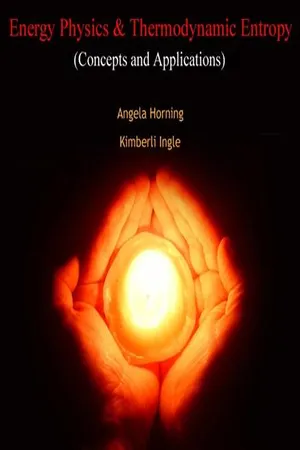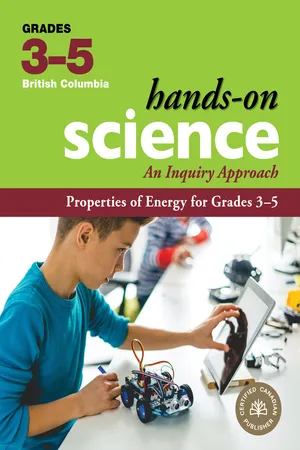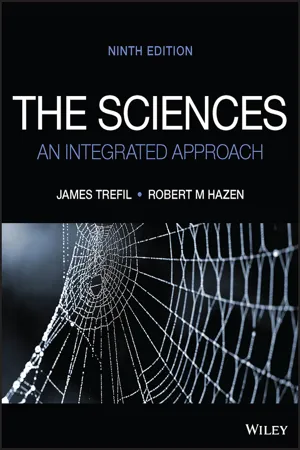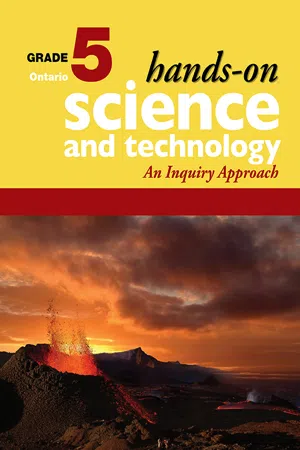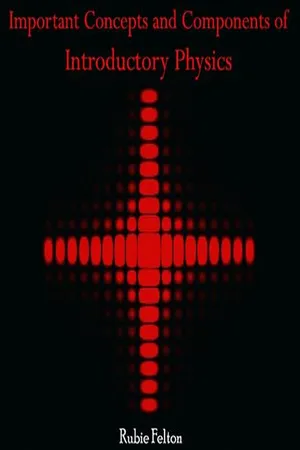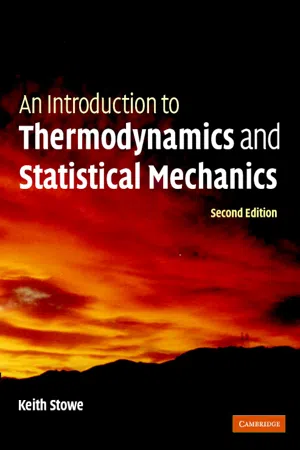Physics
Forms of Energy
Forms of energy refer to the various ways in which energy can manifest, including kinetic energy (energy of motion), potential energy (stored energy), thermal energy (heat), chemical energy (energy stored in chemical bonds), electrical energy, and more. These forms can be converted from one to another, following the principles of conservation of energy.
Written by Perlego with AI-assistance
Related key terms
1 of 5
12 Key excerpts on "Forms of Energy"
- No longer available |Learn more
- (Author)
- 2014(Publication Date)
- Academic Studio(Publisher)
The above list of the known possible Forms of Energy is not necessarily complete. Whenever physical scientists discover that a certain phenomenon appears to violate the law of energy conservation, new forms may be added, as is the case with dark energy, a hypothetical form of energy that permeates all of space and tends to increase the rate of expansion of the universe. Classical mechanics distinguishes between potential energy, which is a function of the position of an object, and kinetic energy, which is a function of its movement. Both position and move-ment are relative to a frame of reference, which must be specified: this is often (and originally) an arbitrary fixed point on the surface of the Earth, the terrestrial frame of reference. It has been attempted to categorize all Forms of Energy as either kinetic or potential: this is not incorrect, but neither is it clear that it is a real simplification, as Feynman points out: These notions of potential and kinetic energy depend on a notion of length scale. For example, one can speak of macroscopic potential and kinetic energy, which do not include thermal ______________________________ WORLD TECHNOLOGIES ______________________________ potential and kinetic energy. Also what is called chemical potential energy (below) is a macro-scopic notion, and closer examination shows that it is really the sum of the potential and kinetic energy on the atomic and subatomic scale. Similar remarks apply to nuclear potential energy and most other Forms of Energy. This dependence on length scale is non-problematic if the various length scales are decoupled, as is often the case ... but confusion can arise when different length scales are coupled, for instance when friction converts macroscopic work into microscopic thermal energy. - No longer available |Learn more
- (Author)
- 2014(Publication Date)
- White Word Publications(Publisher)
For fuels, the energy per unit volume is sometimes a useful parameter. In a few applications, comparing, for example, the effectiveness of hydrogen fuel to gasoline it turns out that hydrogen has a higher specific energy than does gasoline, but, even in liquid form, a much lower energy density . ________________________ WORLD TECHNOLOGIES ________________________ Forms of Energy Heat, a form of energy, is partly potential energy and partly kinetic energy. In the context of physical sciences, several Forms of Energy have been defined. These include: • Thermal energy, thermal energy in transit is called heat • Chemical energy • Electrical energy • Radiant energy, the energy of electromagnetic radiation • Nuclear energy • Magnetic energy • Elastic energy • Sound energy • Mechanical energy • Luminous energy These energies may be divided into two main groups; kinetic energy and potential energy. Other familiar types of energy are a varying mix of both potential and kinetic energy. Energy may be transformed between these forms. The above list of the known possible Forms of Energy is not necessarily complete. Whenever physical scientists discover that a certain phenomenon appears to violate the law of energy conservation, new forms may be added, as is the case with dark energy, a ________________________ WORLD TECHNOLOGIES ________________________ hypothetical form of energy that permeates all of space and tends to increase the rate of expansion of the universe. Classical mechanics distinguishes between potential energy, which is a function of the position of an object, and kinetic energy, which is a function of its movement. Both position and movement are relative to a frame of reference, which must be specified: this is often (and originally) an arbitrary fixed point on the surface of the Earth, the terrestrial frame of reference. - eBook - PDF
- James Shipman, Jerry Wilson, Charles Higgins, Bo Lou, James Shipman(Authors)
- 2020(Publication Date)
- Cengage Learning EMEA(Publisher)
Cengage Learning reserves the right to remove additional content at any time if subsequent rights restrictions require it. 4.5 Forms of Energy and Consumption 95 Did You Learn? ● ● A 2-hp engine can do twice as much work as a 1-hp engine in the same time, or the same amount of work in half the time. ● ● The kilowatt-hour (kWh) is a unit of energy (E 5 Pt). 4.5 Forms of Energy and Consumption Key Questions ● ● How many common Forms of Energy are there, and what are they? ● ● What are the two leading fuels consumed in the United States, and which is used more in the generation of electricity? Forms of Energy We commonly talk about various Forms of Energy such as chemical energy and electrical energy. Many Forms of Energy exist, but the main unifying concept is the conservation of energy. Energy cannot be created or destroyed, but it can change from one form to another. In considering the conservation of energy to its fullest, there has to be an accounting for all the energy. Consider a swinging pendulum. The kinetic and potential energies of the pendulum bob change at each point in the swing. Ideally, the sum of the kinetic and potential energies—the total mechanical energy—would remain constant at each point in the swing and the pendulum would swing indefinitely. In the real world, however, the pendulum will eventually come to a stop. Where did the energy go? Of course, friction is involved. In most practical situations, the kinetic and potential energies of objects eventually end up as heat. Heat, or thermal energy, will be examined at some length in Chapter 5.2, but for now let’s just say that heat is transferred energy that becomes associated with kinetic and potential energies on a molecular level. We have already studied gravitational potential energy. The gravitational potential energy of water is used to generate electricity in hydroelectric plants. Electricity may be described in terms of electrical force and electrical energy (Chapter 8.2). - eBook - PDF
Properties of Energy for Grades 3-5
An Inquiry Approach
- Jennifer E. Lawson, Jennifer E. Lawson, Jennifer E. Lawson, Jennifer E. Lawson(Authors)
- 2022(Publication Date)
- Portage & Main Press(Publisher)
Sound energy moves through a medium in the form of waves. Thermal energy (heat energy): the energy of moving particles of matter. Elastic energy: the energy caused by the stretching or pushing together of some materials (e.g., elastic bands, springs, the string on a bow). Nuclear energy: the energy stored in the nucleus of particles that make up matter. Chemical energy: potential energy stored in the chemical bonds of a substance (e.g., batteries, gasoline, candle wax, food). It can be released in the form of other energies such as thermal energy or electrical energy. Magnetic energy: the energy that operates within a magnetic field. Gravitational energy (gravitational potential energy): the potential to move downwards, in response to Earth’s gravitational pull. An object gains gravitational energy when it moves or is lifted to a higher position. For example, when you lift a pen from the floor to a table, the pen gains gravitational energy, and when you drop it, the pen’s gravitational energy is converted to kinetic energy, and it moves toward the floor. Electrical energy: the energy of charged particles. Muscular energy: the energy found in animals and people. Chemical energy from food becomes muscular energy in animals and people. Radiant energy: energy that travels through space at the speed of light in waves or rays. Sunlight is one kind of radiant energy; so are X-rays, microwaves, and radio waves. Potential energy: energy stored or reserved for future use. For example, dry cells and batteries store potential energy that can be converted to other Forms of Energy. When you hold a basketball, it is not yet moving, but it has potential energy. It has the ability to fall when it is released because its height gives it gravitational potential energy. Power is the rate at which energy is used. The measurement of power is a measurement of how fast energy is used. - John Reisel(Author)
- 2021(Publication Date)
- Cengage Learning EMEA(Publisher)
2.2 TYPES OF ENERGY Just as Julius Caesar said that all of Gaul is divided into three parts, for our purposes we can say that all of the energy of a substance is divided into three parts: internal energy, kinetic energy, and potential energy. Although each of these forms plays a prominent role in certain applications, they are usually not equally important. As we will see later, and as illustrated in Figure 2.1, we can neglect various Forms of Energy in a system depending on the application; this will simplify our thermodynamic problems. FIGURE 2.1 The total energy of a system is the combination of the system’s internal energy, kinetic energy, and potential energy. Internal Energy Kinetic Energy Total Energy Potential Energy Copyright 2022 Cengage Learning. All Rights Reserved. May not be copied, scanned, or duplicated, in whole or in part. Due to electronic rights, some third party content may be suppressed from the eBook and/or eChapter(s). Editorial review has deemed that any suppressed content does not materially affect the overall learning experience. Cengage Learning reserves the right to remove additional content at any time if subsequent rights restrictions require it. 37 2.2 Types of Energy 2.2.1 Potential Energy Potential energy is the energy in a system resulting from the system being in a gravitational field, and it is due to the mass of the system being higher than some reference point. There is the potential for the substance to produce an effect, and this potential will be unleashed if the sub- stance is allowed to fall under the effect of gravity toward the reference point—typically the ground or floor. A sub- stance that does not change its height during a process retains its initial potential energy. For example, as shown in Figure 2.2, a ball that is being held out a window has potential energy, but no changes are produced until the ball is released. Until the ball is released, the potential energy contained in the ball is essentially useless.- Heat, he declared, is just another form of energy. • WAVE ENERGY Anyone who has watched surf battering a seashore has firsthand knowledge of wave energy. In the case of water waves, the type of energy involved is obvious. Large amounts of water are in rapid motion and therefore possess kinetic energy. It is this energy that we see released when waves hit the shore. Other kinds of waves possess energy, as well. For example, when a sound wave is generated, molecules in the air are set in motion and the energy of the sound wave is associated with the kinetic energy of those molecules. Similar sound waves traveling through the solid earth, called seismic waves, can carry the potentially destructive energy that is unleashed in earthquakes (see Chapter 17). In Chapter 6, we will meet another important kind of wave, the kind associated with electromagnetic radiation, such as the radiant energy (light) that streams from the Sun. This kind of wave stores its energy in changing electrical and magnetic fields. Thus, each type of wave possesses one of the Forms of Energy that we have been discussing. Because different types of waves have many similarities, as we shall discuss in Chapter 6, we group them together here. MASS AS ENERGY The discovery that certain atoms, such as uranium, spontaneously release energy as they disintegrate—the phenomenon of radioactivity—led to the realization in the early twen- tieth century that mass is a form of energy. This principle is the focus of Chapter 7, but the main idea is summarized in Albert Einstein’s most famous equation. In words: Every object at rest contains potential energy equivalent to the product of its mass times a constant, which is the speed of light squared. In equation form: energy (joules) mass (kg) [speed of light (m s)] 2 In symbols: E mc 2 where c is the symbol for the speed of light, a constant equal to 300,000,000 meters per second (3 10 8 m s).
- eBook - PDF
The Sciences
An Integrated Approach
- James Trefil, Robert M. Hazen(Authors)
- 2022(Publication Date)
- Wiley(Publisher)
We’ll (a) (b) (c) Education Images/Getty Images Leslie Garland Picture Library/Alamy Belish/Adobe Stock FIGURE 3.6 Potential energy comes in many forms: a precariously perched boulder (a) has gravitational potential energy, sticks of dynamite (b) store chemical potential energy, and a tautly drawn bow (c) holds elastic potential energy. 3.2 | Forms of Energy 73 examine details of the structure and behavior of atoms and molecules, which are much too small to be seen with an ordinary light microscope, in Chapters 8 through 10. A key discovery regarding these minute particles is that the properties of all the materials in our environment depend on their constituent atoms and how they’re linked together. The contrast between solid ice, liquid water, and gaseous steam, all of which are made from molecules of three atoms (two hydrogen atoms linked to one oxygen atom, or H 2 O), for example, is a consequence of how strongly adjacent atoms or molecules interact with each other (Chapter 10). The key to understanding the nature of heat is that all atoms and molecules are in constant random motion. These particles that make up all matter move around and vibrate, and therefore these particles possess kinetic energy. The tiny forces that they exert only affect other atoms and molecules, but the small scale doesn’t make the forces any less real. If molecules in a material begin to move more rapidly, then they have more kinetic energy and are capable of exerting greater forces on each other in collisions. If you touch an object whose molecules are moving fast, then the collisions of those molecules with molecules in your hand will exert greater force, and you will perceive the object to be hot. By contrast, if the molecules in your hand are moving faster than those of the object you touch, then you will perceive the object to be cold. What we normally call heat, therefore, is simply thermal energy—the random kinetic energy of atoms and molecules. - eBook - PDF
Hands-On Science and Technology for Ontario, Grade 5
An Inquiry Approach
- Jennifer E. Lawson, Jennifer Lawson(Authors)
- 2020(Publication Date)
- Portage & Main Press(Publisher)
Muscular energy: energy found in animals. Chemical energy from food becomes muscular energy in animals. Elastic energy: energy caused by the stretching or pushing together of some materials Nuclear energy: the energy stored in the nucleus of particles that make up matter Mechanical energy: energy of an object with moving parts (e.g., swing, pulley) Heat energy: energy of fast-moving particles of matter Electrical energy: energy of charged particles Sound energy: energy that moves through a medium in the form of waves, which are caused by the vibration of objects Radiant or light energy: energy given off by stars, fire, electric lights, and lightning Potential energy: energy that is stored or reserved for future use (e.g., dry cells, batteries) A held basketball has potential energy because it has the capacity to fall when released. Kinetic energy: energy of motion (e.g., a falling or kicked ball) 21 st Century Competencies Critical Thinking and Communication: Building on the previous lesson, students will look more closely at how energy is transformed in everyday situations and understand the difference between potential and kinetic energy. Materials ■ Keepers of the Earth: Native Stories and Environmental Activities for Children by Michael J. Caduto and Joseph Bruchac ■ pencils ■ candles ■ candleholders ■ matches ■ pan filled with water ■ toy that uses batteries to produce motion ■ batteries for the toy ■ Chart: Forms of Energy (4.2.1) (Copied onto chart paper.) ■ cardboard (15 cm x 15 cm piece for each student) ■ scissors ■ rulers ■ elastic bands ■ masking tape ■ stapler ■ pencil crayons ■ Activity Sheet A: Forms of Energy (4.2.2) ■ Activity Sheet B: Wacky Stored-Energy Cards (4.2.3) ■ Learning-Centre Task Card: Energy Mosaic (4.2.4) ■ poster paper ■ glue ■ computers/tablets with Internet access ■ word splash (from lesson 1) ■ Science and Technology Glossary (4.1.3) Activate Review students’ ideas about energy. - No longer available |Learn more
- (Author)
- 2014(Publication Date)
- Learning Press(Publisher)
These can be categorized in two main classes: potential energy and kinetic energy. Kinetic energy can be best understood by examples that demonstrate how it is tran-sformed to and from other Forms of Energy. For example, a cyclist will use chemical energy that was provided by food to accelerate a bicycle to a chosen speed. This speed can be maintained without further work, except to overcome air-resistance and friction. The energy has been converted into kinetic energy, the energy of motion, but the process is not completely efficient and produces heat within the cyclist. The kinetic energy in the moving cyclist and the bicycle can be converted to other forms. For example, the cyclist could encounter a hill just high enough to coast up, so that the bicycle comes to a complete halt at the top. The kinetic energy has now largely been converted to gravitational potential energy that can be released by freewheeling down the other side of the hill. Since the bicycle lost some of its energy to friction, it will never regain all of its speed without further pedaling. Note that the energy is not destroyed; it has only been converted to another form by friction. Alternatively the cyclist could connect a dynamo to one of the wheels and also generate some electrical energy on the descent. The bicycle would be traveling more slowly at the bottom of the hill because some of the energy has been diverted into electrical energy. Another possibility would be for the cyclist to apply the brakes, in which case the kinetic energy would be dissipated through friction as thermal energy. Like any physical quantity which is a function of velocity, the kinetic energy of an object depends on the relationship between the object and the observer's frame of reference. Thus, the kinetic energy of an object is not invariant. Spacecraft use chemical energy to take off and gain considerable kinetic energy to reach orbital velocity. - eBook - PDF
General Chemistry I as a Second Language
Mastering the Fundamental Skills
- David R. Klein(Author)
- 2015(Publication Date)
- Wiley(Publisher)
Let’s start with kinetic energy. When a soccer ball is in motion, it has kinetic energy (you might even remember the term 1 ⁄ 2 mv 2 from your high school physics class). When the soccer ball hits another ball, it will transfer some of its energy to the other ball. Molecules can do the same thing. A molecule in motion has kinetic energy that it can transfer when it collides with another molecule. In this chapter, we will spend most of our time focusing on a new concept, called heat of reaction, which we will see is a measure of the transfer of kinetic energy. Potential energy is the energy associated with position. For example, if you lift an object high in the air, then it has potential energy associated with its height in the gravitational field of the earth. If you let go of the object, it will fall down and smash on the ground (the potential energy is being released, and converted into kinetic energy). There are many ways to have potential energy. We just saw that an object in a gravitational field has potential energy. Two charged particles separated by a distance also have potential energy. This is the kind of potential energy that you will learn more about in the second semester (electrochemical potential energy). At this point in the game, we will focus our discussions on kinetic energy. When we talk about the total energy of a system, we are referring to the sum total of all kinds of energy (the sum of the kinetic energy and every kind of po- tential energy) for each and every particle in the system. We use the symbol E to refer to this sum total of all of the energy in a system (some textbooks use the sym- bol U). The energy of a system can only change when the system exchanges energy with the surroundings. So, if we are talking about a chemical reaction, then the re- action flask is the system, and the surroundings are the rest of the universe. - eBook - PDF
Janice VanCleave's Energy for Every Kid
Easy Activities That Make Learning Science Fun
- Janice VanCleave(Author)
- 2005(Publication Date)
- Wiley(Publisher)
In other words, it is the sum of mechanical kinetic energy (a form of mechanical energy in which the energy of an object is due to the motion of the object) and mechanical potential energy (a form of mechanical energy in which the energy of an object is due to its position or condition). All kinetic energy is mechanical energy, but all mechanical energy is not kinetic energy. Some mechanical energy is potential energy. There are different forms of potential energy, including chemical and mechanical. Chemical poten- tial energy describes the potential energy stored in the bonds holding atoms together. Mechanical potential energy describes the potential energy of an object that is capable of motion because of its position or condition. A compressed spring is an example of mechanical potential energy. An object can have both mechanical potential energy and mechanical kinetic energy at the same time. For example, when a ball is dropped, it starts to fall. As the ball falls, more and more of its potential energy is transferred to kinetic energy. The law of conservation of mechanical energy states that the sum of the mechanical potential energy and 6 Sum It Up 41 the mechanical kinetic energy of an object remains the same as long as no outside force, such as friction, acts on it. So before the ball is dropped, it has maximum potential energy and zero kinetic energy. Halfway through the fall, the poten- tial and kinetic energy are equal. When the ball strikes the ground, it has maximum kinetic energy and zero potential energy. Exercises 1. Study the figures and determine which figure, A or B, represents: a. mechanical potential energy b. mechanical kinetic energy 42 Energy for Every Kid Sum It Up 43 2. Which position in the figure, A, B, or C, shows the child with both mechanical potential and mechanical kinetic energy? Activity: MAGIC CAN Purpose To demonstrate how friction affects the change between mechanical potential and mechanical kinetic energy. - Keith Stowe(Author)
- 2007(Publication Date)
- Cambridge University Press(Publisher)
Part III Energy and the first law Chapter 4 Internal energy A The general idea 65 B Potential energies 65 B.1 General thoughts 65 B.2 Solids, liquids, and gases 68 C Quantum effects 69 C.1 Rotations and vibrations 69 C.2 Example --the diatomic gas molecule 70 D Degrees of freedom 70 E Equipartition 71 F Thermal energy 72 A The general idea Our investigations of larger systems begin with their internal energy, which involves the relative motion and interactions among the system’s own particles. It does not include interactions with or motion relative to objects outside the system. The internal energy of a nail, for example, would include the energy of vibra-tion of the atoms and the motions and interactions of the conduction electrons (Figure 4.1). But it would not include the nail’s potential energy or motion relative to the Earth, for example. Of course, if you enlarge the system to include both the Earth and the nail, then these would be part of the internal energy of this larger system, but they are not part of the internal energy of the nail by itself. B Potential energies We now examine the energies of the individual particles in solids, liquids, and gases, by means of models that are useful in developing intuition for these systems. B.1 General thoughts Imagine a particle that is anchored in place by interactions with its neigh-bors. We can use a Taylor series expansion (Appendix B) to write its potential 65 66 Introduction to thermodynamics and statistical mechanics Figure 4.1 (a) The internal energy of a nail includes such things as the vibrations of the iron atoms and the potential and kinetic energies of the conduction electrons. (b) If the nail were thrown over a cliff, its motion relative to the Earth and its potential energy due to the Earth’s gravity would not be part of its internal energy, because they involve more than just the nail itself.
Index pages curate the most relevant extracts from our library of academic textbooks. They’ve been created using an in-house natural language model (NLM), each adding context and meaning to key research topics.
